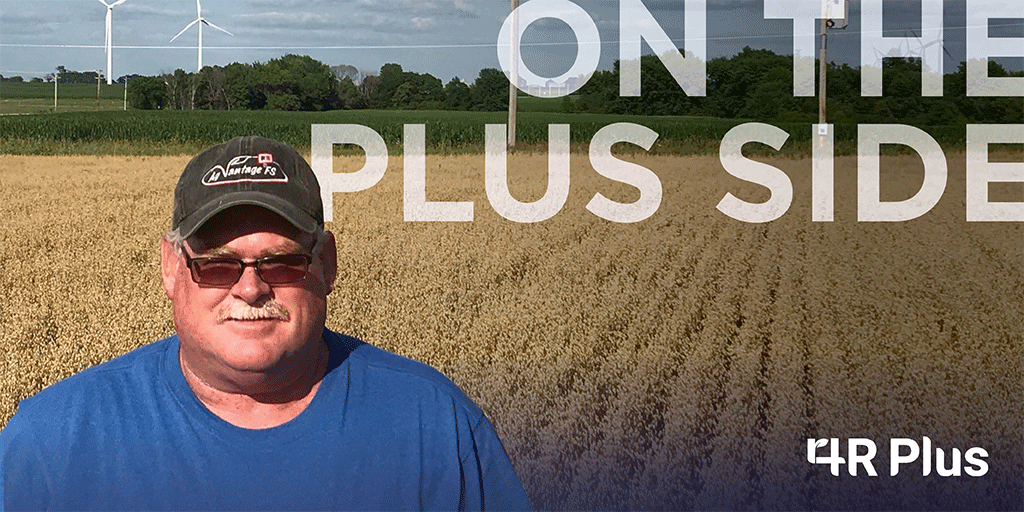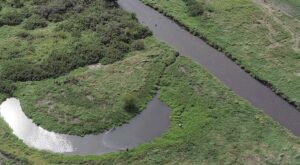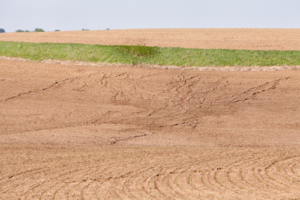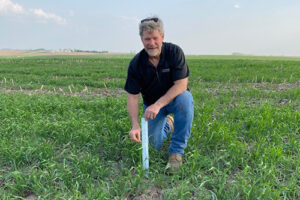By: 4R Plus
July 2021

Floyd County farmer Wayne Koehler’s 4R Plus journey started with a desire to diversify his crop rotation and minimize expenses. On the mostly flat landscape, the fifth-generation farmer now grows corn, soybeans, hay, rye and oats.
The soil health movement piqued his interest about the same time commodity prices were in the doldrums. “I started attending field days and noticed more cover crops being seeded. I had raised oats in the past but made the intentional decision in 2018 to add it into the rotation every year on at least one farm,” he said. “At about the same time, I started raising rye for cover crop seed.”
Koehler seeds red clover with the oats to act as a cover after the oats are harvested. “I have a customer that has been buying the red clover in the fall to make baleage,” he said.
He made a market-based decision not to grow rye in 2021. “I’ve been raising rye as a seed grower and have used that seed for my own cover crops and the excess is purchased by a local cover crop services provider. But this year, I made the decision to purchase my rye seed for cover crops.”
Managing weather challenges
The weather in northern Iowa can pose a challenge for cover crop establishment in the fall and termination in the spring, but Koehler is determined to make it work to improve soil health and suppress weeds. “Cereal rye ahead of soybeans works well to suppress and help control glyphosate-resistant weeds,” he said. “However, I am learning that management of the rye can differ depending on spring weather conditions. Wet and dry springs can require different termination strategies.
“I’ve had success with oats as a cover crop, which doesn’t need to be terminated in the spring, but last year I planted a mix of buckwheat and berseem clover. This mix also didn’t need to be terminated and I was impressed with the quick growth.”
Through his experiments to find the right cover crop mix, one of the Plus Sides is improved plant health. “The corn and soybeans grow faster, and the improved plant health supports the crop through the growing season,” he said. “This is especially true following oats. I’m noticing the soil is more mellow.”
Transitioning tillage practices
Koehler has been no-tilling soybeans for years and has a separate planter for corn. “I had the vision after several years of success to gradually switch to no-till corn,” he said. “I have incrementally added precision technology and attachments to my corn planter.”
Row cleaners that are adjustable on the go from the tractor cab are especially helpful. “Every field is different, and conditions can vary within a field,” he said. “You need to be alert and make those adjustments. Active down pressure that measures the amount of weight on the gauge wheels of each row unit and adjusts automatically helps with no-till and gives you a better chance for success in the transition.”
Patience also goes a long way. “Having two planters helps me switch from planting soybeans to corn quickly,” he said. “During a wet spring I can plant soybeans while we wait for conditions to be favorable for corn.”
Koehler also tested no-till corn on a few acres before expanding. “Everything went really well this spring. Like many, we faced a dry spring and there was a lot of dust flying at planting time on the tilled fields,” he said. “My no-till corn got off to a nice start because the little bit of soil moisture that we had was preserved.”
Soil fertility is important to consider before switching to no-till corn. “Before I made the switch, I made sure soil tests revealed fertility was ample,” he said. “You also need to assess field drainage.”
His no-till corn and soybeans were impacted by the late-May freeze. “It’s frustrating because the tilled fields that absorbed more heat during the day were largely protected,” he added.
Looking ahead at the long-term benefits of 4R Plus practices
With that event in his rearview mirror, Koehler recognizes the value of improving the soil’s organic matter, protecting against wind and water erosion all while protecting water quality. “I’m sensitive that what we do on the farm can have a larger impact downstream,” he said. “I monitor tile lines when there’s water flowing and have widened buffer and filter strips because I want to be part of the solution.”
With the vast majority of Iowa covered by some form of drought, like many others, Koehler says his crops need timely rains to sustain the yield that is there. “When considering a 4R Plus practice, keep the long-term benefits in mind,” he advised. “It was hard for me to replant soybeans when my neighbors that tilled their fields didn’t have to go through that process. But for the long term, we need to do what is right for the soil and the environment and not have a knee-jerk reaction to the extremes we encounter.”
Koehler encourages farmers to take advantage of cost-share resources, attend field days and plan a trial of a practice that interests them. “We are fortunate in Iowa to have multiple organizations that provide support to farmers wanting to start a new practice to conserve the soil,” he said.



